 W
WIvory carving is the carving of ivory, that is to say animal tooth or tusk, generally by using sharp cutting tools, either mechanically or manually.
 W
WThe Aachen Gospels are a Carolingian illuminated manuscript which was created at the beginning of the ninth century by a member of the Ada School. The Evangeliary belongs to a manuscript group which is referred to as the Ada Group or Group of the Vienna Coronation Gospels. It is part of the church treasury of Charlemagne's Palatine Chapel, now Aachen Cathedral, and is today kept in the Aachen Cathedral Treasury. The Treasury Gospels and the more recent Ottonian Liuthar Gospels are the two most significant medieval manuscripts on display there.
 W
WThe Adorant from the Geißenklösterle cave is a 35,000-to-40,000-year-old section of mammoth ivory with a depiction of a human figure, found in the Geißenklösterle cave in the Swabian Jura near Blaubeuren, Germany.
 W
WThe Reliquary Cross is a late 10th century Anglo Saxon ivory figure of Christ, set on an Ottonian cross to make a reliquary in the form of a crucifix. It is now in the Victoria and Albert Museum in London.
 W
WAthena Parthenos is a lost massive chryselephantine sculpture of the Greek goddess Athena, made by Phidias and his assistants and housed in the Parthenon in Athens; this statue was designed as its focal point. Parthenos 'maiden, virgin' was an epithet of Athena. There have been many replicas and works inspired by the statue, in both ancient and modern times. Athena was the Greek goddess of wisdom.
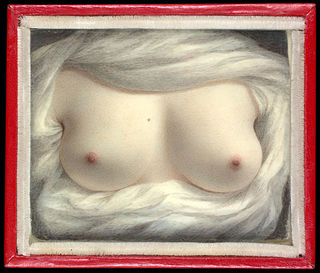 W
WBeauty Revealed is an 1828 self-portrait by the American artist Sarah Goodridge, a watercolor portrait miniature on a piece of ivory. Depicting only the artist's bared breasts surrounded by white cloth, the 6.7-by-8-centimeter painting, originally backed with paper, is now in a modern frame. Goodridge, aged forty when she completed the miniature, depicts breasts that appear imbued with a "balance, paleness, and buoyancy" by the harmony of light, color, and balance. The surrounding cloth draws the viewer to focus on them, leading to the body being "erased".
 W
WThe Begram ivories are a group of over a thousand decorative plaques, small figures and inlays, carved from ivory and bone, and formerly attached to wooden furniture, that were excavated in the 1930s in Bagram (Begram), Afghanistan. They are rare and important exemplars of Kushan art of the 1st or 2nd centuries CE, attesting to the cosmopolitan tastes and patronage of local dynasts, the sophistication of contemporary craftsmanship, and to the ancient trade in luxury goods.
 W
WThe Benin ivory mask is a miniature sculptural portrait in ivory of Idia, the first Iyoba of the 16th century Benin Empire, taking the form of a traditional African mask.
 W
WThe Brescia Casket or Lipsanotheca is an ivory box, perhaps a reliquary, from the late 4th century, which is now in the Museo di Santa Giulia at San Salvatore in Brescia, Italy. It is a virtually unique survival of a complete Early Christian ivory box in generally good condition. The 36 subjects depicted on the box represent a wide range of the images found in the evolving Christian art of the period, and their identification has generated a great deal of art-historical discussion, though the high quality of the carving has never been in question. According to one scholar: "despite an abundance of resourceful and often astute exegesis, its date, use, provenance, and meaning remain among the most formidable and enduring enigmas in the study of early Christian art".
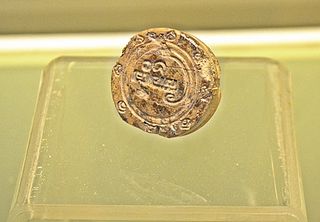 W
WThe Butuan Ivory Seal or BIS is an ivory stamp or seal stamp or a privy seal associated with a Rhinoceros Ivory Tusk, dated 9th–12th century, was found in Libertad, Butuan in Agusan del Norte in southern Philippines. Inscribed on the seal is the word Butban in stylized Kawi. The script has a similarity to the Tagalog script. Butban, was presumed to stand for Butwan or Butuan, since the letters “b” and “w” were frequently interchanged. The ivory seal is now housed at the National Museum of the Philippines.
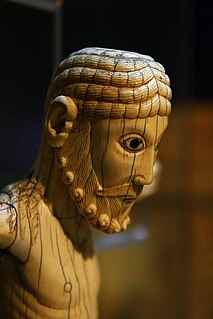 W
WThe Carrizo Christ is an 11th-century ivory carving and is conserved in the Museo de León, León (Spain). The figure is 13 inches (33 cm) high. The piece came from the Cistercian monastery of Santa María de Carrizo located some 16 miles west of León.
 W
WThe object called by the museum Casket with Scenes of Romances is a French Gothic ivory casket made in Paris between 1330 and 1350, and now in the Walters Art Museum, Baltimore, Maryland. The casket is 4 5/8 inches high, 9 15/16 inches wide and 5 1/16 inches deep.
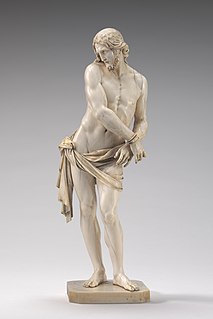 W
WChrist Bound is an ivory sculpture by Flemish sculptor François Duquesnoy, executed in the 1620s. It is currently housed at the National Gallery of Art in Washington, D.C., which acquired it in June 2007.
 W
WChryselephantine sculpture is sculpture made with gold and ivory. Chryselephantine cult statues enjoyed high status in Ancient Greece.
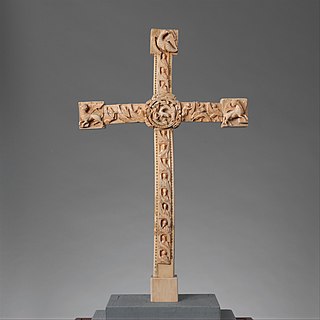 W
WThe Cloisters Cross, also referred to as the Bury St Edmunds Cross, is a complex 12th-century ivory Romanesque altar cross in The Cloisters, part of the Metropolitan Museum of Art in New York. The cross is carved from walrus ivory.
 W
WThe Clonard chess piece is an historic bone or ivory playing piece depicting a queen seated on a throne, found in a bog in Clonard, Co. Meath, Ireland, some time before 1817. The piece dates from the late twelfth century A.D and is held by the National Museum of Ireland in Dublin.
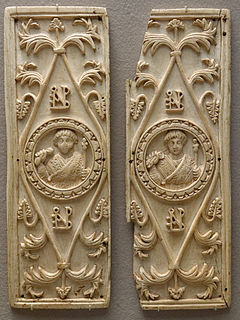 W
WIn Late Antiquity, a consular diptych was a type of diptych intended as a de-luxe commemorative object. The diptychs were generally in ivory, wood or metal and decorated with rich relief sculpture. A consular diptych was commissioned by a consul ordinarius to mark his entry to that post, and was distributed as a commemorative reward to those who had supported his candidature or might support him in future.
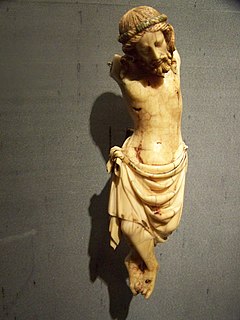 W
WThe Crucified Christ is a sculpture in walrus ivory, probably from Paris c 1300, now in The Cloisters, New York. It is lined with traces of paint and gilding. Although small in scale, it is structured in a monumental style. It shows the dead and crucified body of Christ; in the 12th century the dead Christ was widely seen as representing human suffering. This work is noted for its high quality craftsmanship, and the subtle and sensitive rendering of the torso. The stunted legs are a notable and somewhat inexplicable feature.
 W
WThe crucifix of Ferdinand and Sancha is an ivory carving from circa 1063, today in the National Archaeological Museum of Spain. It was part of an offering by King Ferdinand I of León and Queen Sancha to furnish the basilica of San Isidoro de León. It is the earliest known crucifix from Spain depicting the body of Christ. Although earlier Spanish crucifixes of gold, ivory and wood are known, they are all without images. The official inventory of the royal gift describes the crucifix as "a cross of ivory with the image of our crucified Redeemer". It measures 52 cm high, 34.5 cm wide, and 1 cm thick, with the width of the cross beams being 7 cm. The image of Christ is 305 mm tall.
 W
WA diptych is any object with two flat plates which are a pair, these are often attached at a hinge. For example, the standard notebook and school exercise book of the ancient world was a diptych consisting of a pair of such plates that contained a recessed space filled with wax. Writing was accomplished by scratching the wax surface with a stylus. When the notes were no longer needed, the wax could be slightly heated and then smoothed to allow reuse. Ordinary versions had wooden frames, but more luxurious diptychs were crafted with more expensive materials.
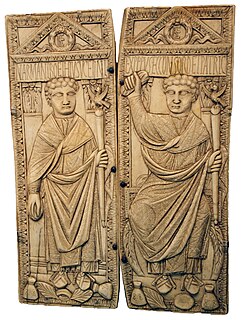 W
WThe Diptych of Boethius is an ivory consular diptych, which dates from the end of the fifth century AD and is conserved in the Museo di Santa Giulia in Brescia.
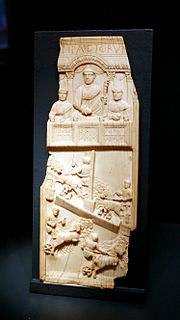 W
WThe Diptych of the Lampadii is an ivory diptych, measuring 27x9x2 cm) dating to the beginning of the Fifth century AD. Only the left plate, which is kept in the Museo di Santa Giulia in Brescia, survives.
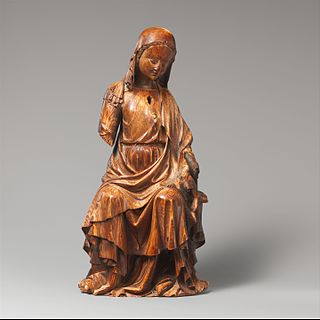 W
WThe Enthroned Virgin and Child is a statuette in elephant ivory dated to between 1290 and 1300, now at The Cloisters in New York. Originating probably from London, certainly English, it is today badly damaged. It originally showed a seated Virgin Mary, holding the child Christ, most of whose body is now lost, but at one time was perched on her left knee looking upwards. Only the toes of his left foot and part of his left leg and foot survive. It has a reddish-brown appearance, probably from a staining agent used in restoration.
 W
WThe Evangelium longum is an illuminated manuscript evangeliary that was made around 894 at the Abbey of Saint Gall in Switzerland.
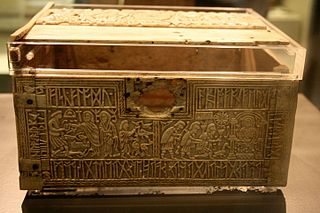 W
WThe Franks Casket is a small Anglo-Saxon whale's bone chest from the early 8th century, now in the British Museum. The casket is densely decorated with knife-cut narrative scenes in flat two-dimensional low-relief and with inscriptions mostly in Anglo-Saxon runes. Generally reckoned to be of Northumbrian origin, it is of unique importance for the insight it gives into early Anglo-Saxon art and culture. Both identifying the images and interpreting the runic inscriptions has generated a considerable amount of scholarship.
 W
WIn Late Antiquity, an imperial diptych is a theoretical type of ivory diptych, made up of two leaves of five panels each and each with a central panel representing the emperor or empress. They are so-named in contrast to consular diptychs. They were produced as unique examples, whereas each consular diptych was produced in large numbers to offer to the emperor on certain occasions, principally a nobleman's entry to the consulship.
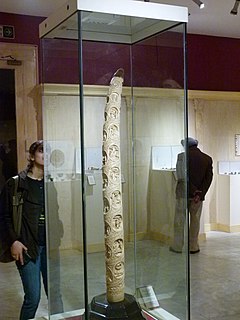 W
WCarved elephant tusk depicting Buddha life stories is an intricately carved complete single tusk now exhibited at the Decorative Arts gallery, National Museum, New Delhi, India. This tusk was donated to the Museum. This tusk, which is nearly five foot long, illustrates forty three events in the life of the Buddha and is thought to have been made by early 20th century craftsmen from the Delhi region.
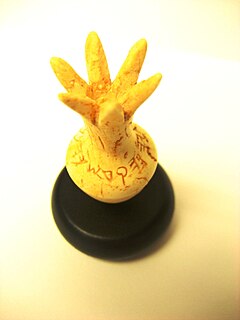 W
WThe ivory pomegranate is a thumb-sized semitic ornamental artifact acquired by the Israel Museum. It is not actually made of ivory, but of hippopotamus bone and bears an inscription; Holy (Sacred) to the Priest of the House of God (YHWH).
 W
WThe John Grandisson Triptych is an ivory triptych carved in England around 1330 AD. Since 1861, it has been part of the British Museum's collection.
 W
WThe Khufu Statuette or the Ivory figurine of Khufu is an ancient Egyptian statue. Historically and archaeologically significant, it was found in 1903 by Sir William Matthew Flinders Petrie during excavation of Kom el-Sultan in Abydos, Egypt. It depicts Khufu, a Pharaoh of the Fourth dynasty, and the builder of the Great Pyramid.
 W
WKongo ivories are some of the finest sculptural works produced by the people of the west-central Africa's Lower Congo region. In the Kongo Kingdom, ivory was a precious commodity that was strictly controlled by chiefs and kings, who commissioned sculptors to produce fine ivory sculptures for their personal and courtly use. With the rise of the transatlantic trade, ivory became one of the most valuable African natural resources sought by Western industry. Eventually, Kongo ivory carvers produced works not only for indigenous leaders and elites but also for Europeans and other foreigners.
 W
WThe Lewis chessmen or Uig chessmen, named after the island or the bay where they were found, are a group of distinctive 12th-century chess pieces, along with other game pieces, most of which are carved from walrus ivory. Discovered in 1831 on Lewis in the Outer Hebrides of Scotland, they may constitute some of the few complete, surviving medieval chess sets, although it is not clear if a set as originally made can be assembled from the pieces. When found, the hoard contained 93 artifacts: 78 chess pieces, 14 tablemen and one belt buckle. Today, 82 pieces are owned and usually exhibited by the British Museum in London, and the remaining 11 are at the National Museum of Scotland in Edinburgh.
 W
WThe ninety-three game pieces of the Lewis chessmen hoard were found on the Isle of Lewis in the Outer Hebrides of Scotland. Medieval in origin, they were first exhibited in Edinburgh in 1831 but it is unclear how much earlier they had been discovered. The hoard comprised seventy-eight distinctive chess pieces and fifteen other non-chess pieces, nearly all carved from walrus tusk ivory, and they are now displayed at the British Museum in London and National Museums Scotland in Edinburgh. Another chess piece, which turned up in 1964 and in 2019 was attributed to have come from the original hoard, now belongs to an undisclosed owner.
 W
WThe MacGregor Plaque is an artefact that probably derives from the mastaba tomb of the ancient Egyptian king Den, and dated circa 2985 BCE. According to its inscriptions, the plaque was originally attached to the king's sandal. The artifact appears in McGregor's A History of the World in 100 Objects.
 W
WThe Magdeburg Ivories are a set of 16 surviving ivory panels illustrating episodes of Christ's life. They were commissioned by Emperor Otto I, probably to mark the dedication of Magdeburg Cathedral, and the raising of the Magdeburg see to an archbishopric in 968. The panels were initially part of an unknown object in the cathedral that has been variously conjectured to be an antependium or altar front, a throne, door, pulpit, or an ambon; traditionally this conjectural object, and therefore the ivories as a group, has been called the Magdeburg Antependium. This object is believed to have been dismantled or destroyed in the 1000s, perhaps after a fire in 1049.
 W
WTel Megiddo is the site of the ancient city of Megiddo, the remains of which form a tell, situated in northern Israel near Kibbutz Megiddo, about 30 km south-east of Haifa. Megiddo is known for its historical, geographical, and theological importance, especially under its Greek name Armageddon. During the Bronze Age, Megiddo was an important Canaanite city-state and during the Iron Age, a royal city in the Kingdom of Israel. Megiddo drew much of its importance from its strategic location at the northern end of the Wadi Ara defile, which acts as a pass through the Carmel Ridge, and from its position overlooking the rich Jezreel Valley from the west. Excavations have unearthed 26 layers of ruins since the Chalcolithic phase, indicating a long period of settlement. The site is now protected as Megiddo National Park and is a World Heritage Site.
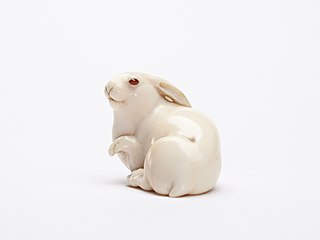 W
WA netsuke is a miniature sculpture that was invented in 17th-century Japan to serve a practical function.
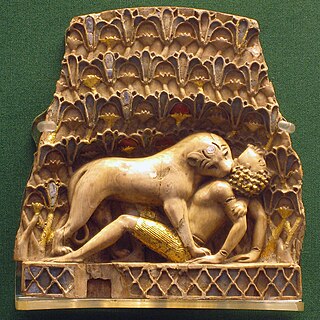 W
WThe Nimrud ivories are a large group of small carved ivory plaques and figures dating from the 9th to the 7th centuries BC that were excavated from the Assyrian city of Nimrud during the 19th and 20th centuries. Most are fragments of the original forms; there are over 1,000 significant pieces, and many more very small fragments.
 W
WOlifant was the name applied in the Middle Ages to ivory hunting horns made from elephants' tusks. One of the most famous olifants belonged to the legendary Frankish knight Roland, protagonist of The Song of Roland.
 W
WThe Palaikastro Kouros is a chryselephantine statuette of a male (kouros) found in the modern-day town of Palaikastro on the Greek island of Crete. It has been dated to the Late Minoan period during the Bronze Age. It is currently on display in the Archaeological Museum of Siteia. Standing roughly 50 cm tall, its large size and the value of its materials indicate that it possessed value as a cult image. The vast majority of its body is made of hippopotamus tooth covered with gold foil. Its head differs slightly in make from the body, crafted from gray-green serpentinite with rock-crystal eyes and detailed further with ivory.
 W
WThe Poet and Muse diptych is a Late Antique ivory diptych that appears to commemorate, and to flatter, the literary pursuits of the aristocrat who commissioned it, so that it stands somewhat apart from the consular diptychs that were carved for distribution to friends and patrons when a man assumed the consular dignity during the later Roman Empire. The original inscription in this example, unusually, will have been carried out on the borders of the reverse side, which was infilled with a layer of wax for writing on, the ivory diptych being a very grand example of a wax tablet; the inscription has not survived, so there can be no way to identify the writer for whom it was made. In the literature that has accumulated about this diptych, various prominent figures have been offered as candidates: Ausonius, Boethius, and Claudian, and even earlier figures, like Ennius and Seneca, with whom the donor wished to be associated
 W
WThe Pompeii Lakshmi is an ivory statuette that was discovered in the ruins of Pompeii, which was destroyed in the eruption of Mount Vesuvius 79 CE. She was found by Amedeo Maiuri, an Italian scholar in 1938. The statuette has been dated to the first-century CE. The statuette is thought of as representing an Indian goddess of feminine beauty and fertility. It is possible that the sculpture originally formed the handle of a mirror. Lakshmi is a reminder of commercial trade of goods and resources between India and Italy in the first century CE. Over the years historians have been able to connect Roman trade with the far east specifically India.
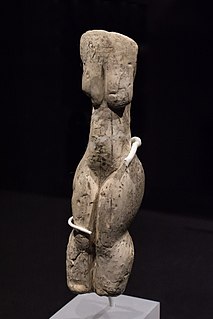 W
WThe Venus of Eliseevichi is a Venus figurine from the Epigravettian.
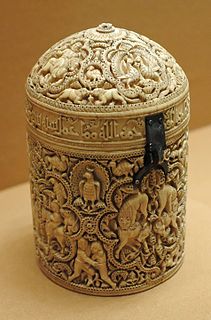 W
WThe pyxis made in 968 CE/357AH for Prince al-Mughira is a portable ivory carved container that dates from Medieval Islam's Spanish Umayyad period. It is in the collection of the Louvre in Paris. The container was made in one of the Madinat al-Zahra workshops, near modern-day Cordoba, Spain and is thought to have been a coming-of-age present for the son of caliph Abd al-Rahman III. Historical sources say that the prince referred to as al-Mughira was Abu al-Mutarrif al-Mughira, the last born son of the caliph ‘Abd al-Rahman III, born to a concubine named Mushtaq. We are certain this pyxis belongs to al-Mughira because of the inscription around the base of the lid which reads: “Blessing from God, goodwill, happiness and prosperity to al-Mughīra, son of the Commander of the Faithful, may God's mercy [be upon him], made in the year 357"
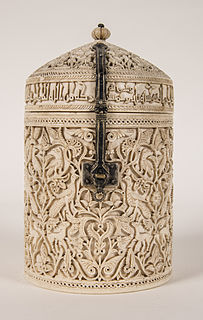 W
WThe Pyxis of Zamora is an carved ivory casket (pyx) that dates from the Caliphate of Córdoba. It is now in the National Archaeological Museum of Spain in Madrid, Spain.
 W
WScrimshaw is scrollwork, engravings, and carvings done in bone or ivory. Typically it refers to the artwork created by whalers, engraved on the byproducts of whales, such as bones or cartilage. It is most commonly made out of the bones and teeth of sperm whales, the baleen of other whales, and the tusks of walruses. It takes the form of elaborate engravings in the form of pictures and lettering on the surface of the bone or tooth, with the engraving highlighted using a pigment, or, less often, small sculptures made from the same material. However, the latter really fall into the categories of ivory carving, for all carved teeth and tusks, or bone carving. The making of scrimshaw probably began on whaling ships in the late 18th century and survived until the ban on commercial whaling. The practice survives as a hobby and as a trade for commercial artisans. A maker of scrimshaw is known as a scrimshander. The word first appeared in print in the early 19th century, but the etymology is uncertain.
 W
WSitula, from the Latin word for bucket or pail, is the term in archaeology and art history for a variety of elaborate bucket-shaped vessels from the Iron Age to the Middle Ages, usually with a handle at the top. All types may be highly decorated, most characteristically with reliefs in bands or friezes running round the vessel.
 W
WThe Situla of the Pania is an ivory situla or pyxis from the end of the seventh century BC, found in the Tomb of the Pania in Chiusi and conserved in the Museo archeologico nazionale di Firenze.
 W
WIvory carving is one of the traditional industries of Sri Lanka. The country's ivory carving industry has a very long history, but its origin is not yet fully understood. During the Kingdom of Kandy, ivory art became very popular and reached at its zenith. These delicate ivory works represent how Sri Lankan craftsmen mastered in this technique.
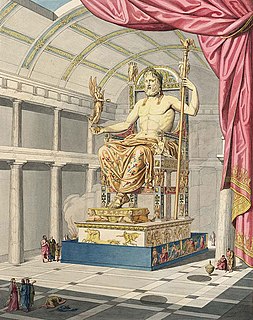 W
WThe Statue of Zeus at Olympia was a giant seated figure, about 12.4 m (41 ft) tall, made by the Greek sculptor Phidias around 435 BC at the sanctuary of Olympia, Greece, and erected in the Temple of Zeus there. Zeus was the sky and thunder god in ancient Greek religion, who ruled as king of the gods of Mount Olympus.
 W
WThe Symmachi–Nicomachi diptych is a book-size Late Antique ivory diptych dating to the late fourth or early fifth century, whose panels depict scenes of ritual pagan religious practices. Both its style and its content reflect a short-lived revival of traditional Roman religion and Classicism at a time when the Roman world was turning towards Christianity and rejecting the Classical tradition.
 W
WThe Venus figurines of Gagarino are eight Palaeolithic Venus figurines made from ivory. The statuettes belong to the Gravettian industry and are about 21,000–20,000 years old. They were discovered near to the village of Gagarino in Lipetsk Oblast, Russia, and are now held in the Hermitage Museum in Saint Petersburg.
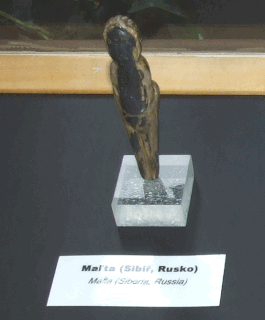 W
WThe Venus figurines of Mal’ta are several palaeolithic figurines of women found in Siberia, Russia.
 W
WThe Venus figurines from Zaraysk are two paleolithic sculptures of the female body. They both consist of mammoth ivory. The age of these Venus figurines is about 20.000 to 14 000 years BC; they stem from the Gravettian. The statuettes were excavated in 2005 by Hizri Amirkhanov and Sergey Lev. Finds from Zaraysk show features of both the Avdeevo culture and the Kostenki culture.
 W
WThe Venus of Brassempouy is a fragmentary ivory figurine from the Upper Palaeolithic, apparently broken from a larger figure at some time unknown. It was discovered in a cave at Brassempouy, France in 1892. About 25,000 years old, it is one of the earliest known realistic representations of a human face.
 W
WThe Venus of Hohle Fels is an Upper Paleolithic Venus figurine made of mammoth ivory that was unearthed in 2008 in Hohle Fels, a cave near Schelklingen, Germany. It is dated to between 40,000 and 35,000 years ago, belonging to the early Aurignacian, at the very beginning of the Upper Paleolithic, which is associated with the earliest presence of Cro-Magnon in Europe.
 W
WThe Venus of Lespugue is a Venus figurine, a statuette of a nude female figure of the Gravettian, dated to between 26,000 and 24,000 years ago.
 W
WThe Venus of Moravany is a small prehistoric female figurine discovered in Slovakia in the early 20th century.
 W
WThe Virgin and Child from the Sainte-Chapelle is an ivory sculpture probably created in the 1260s, currently in the possession of the Louvre Museum in Paris. The museum itself describes it as "unquestionably the most beautiful piece of ronde-bosse [in the round] ivory carving ever made", and the finest individual work of art in the wave of ivory sculpture coming out of Paris in the 13th and 14th centuries.